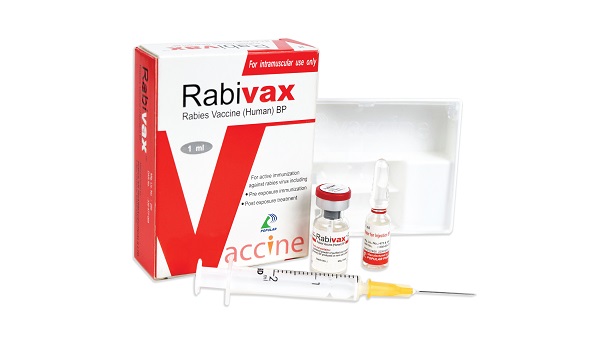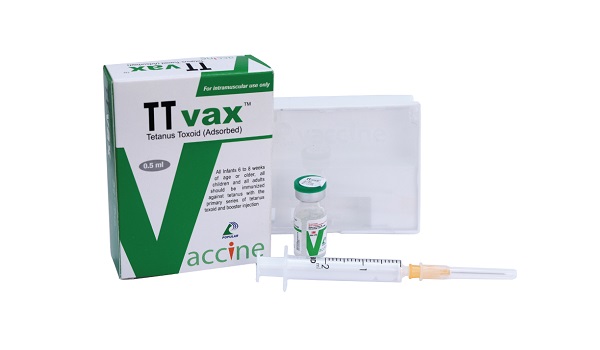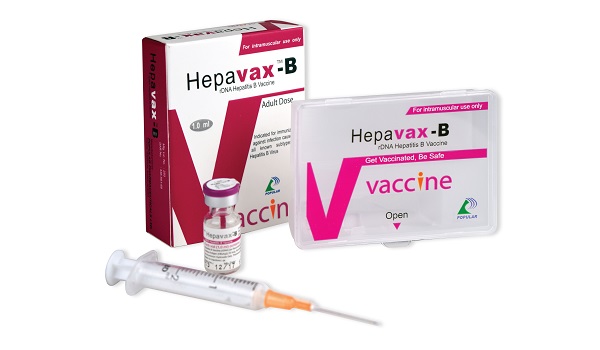Indication
Rabies vaccine is indicated for prophylactic immunization against rabies and treatment of patients following suspected rabies contact.
Pre-exposure immunization
- This vaccination is particularly recommended for:
- Professional groups exposed to frequent contamination
- Veterinary surgeons (including students at veterinary colleges)
- Technical personnel working with veterinary surgeons
- Laboratory personnel handling material contaminated with rabies virus
- Personnel in abattoirs and knackers yards
- Taxidermists
- Gamekeepers, forestry workers and naturalists in enzootic areas
- Infants particularly exposed to the risk of rabies
Post-exposure immunization
- Treatment of subjects bitten by rabid animals or those suspected of being so
- Treatment of contact subjects
Dosage & Administration
To reconstitute the vaccine, transfer content of supplied diluent into the vial containing freeze-dried preparation. After reconstitution the solution should be homogeneous, clear and free from any particles. Vaccine must be injected immediately after reconstitution and the syringe should be destroyed after use.
Method of administration for intramuscular use
The 1 ml dose of Rabivax should be given intramuscularly in the deltoid in adults and in the
anterolateral aspect of the thigh muscle in children under 1 year. It should not be injected into the gluteal region. Do not inject intravenously.
(a) Pre-exposure immunization:
1 ml for children and adults.
Primary-vaccination:
According to the WHO recommendations 1 injection by the intramuscular route on days D0, D7, D21 or D28, followed by a booster dose one year later.
Boosters:
Thereafter, one injection every 5 years or when the titre is found to be less than 0.5 IU/ml
(b) Post-exposure immunization:
Local treatment of the wound:
1. Prompt and gentle
through washing with
soap or detergent and
flushing the wound with
running tap water for at
least 15 minutes
2. After washing, disinfectants
like either ethanol (700 ml/l) or
tincture or aqueous solution of
iodine or povidone iodine must
be applied
3. Don't bandage or suture
the wound.
Vaccination of non-immunized subjects:
Intramuscular schedules:
One intramuscular (IM) dose comprised of 1 ml.
Standard intramuscular (1-1-1-1-1) regimen:
Day 0: 1 injection of 1 ml
Day 3: 1 injection of 1 ml
Day 7: 1 injection of 1 ml
Day 14: 1 injection of 1 ml
Day 28: 1 injection of 1 ml
Or
Abbreviated multisite (2-1-1) regimen.
Day 0: 2 injections each of 1 ml at separate sites
Day 7: 1 injection of 1 ml
Day 21: 1 injection of 1 ml
In case of severe (WHO category 3) wounds, rabies immunoglobulin should be administered as soon as possible with the first dose of rabies vaccine. The anti-rabies immunoglobulin should be used as local wound soakage injections as much as possible, with the rest part for muscle injection. The rabies vaccine should be administered in different injection site.
Vaccination of subjects already immunized:
Patients had complete post exposure immunization schedule within 1 year. Bitten by suspected rabid animal, 1 dose injection is required on Day 0, Day 3, respectively.
Patients had complete post-exposure immunization schedule 1 year ago, Bitten by suspected rabid animal, complete post-exposure immunization required.
Patient had complete immunization schedule and booster immunization within 3 years. Bitten by suspected rabid animal, 1 dose injection is required on Day 0, Day 3, respectively.
Patient had complete immunization schedule and booster immunization 3 years ago. Bitten by suspected rabid animal, complete post-exposure immunization required.
Post-exposure vaccination must be administered on the basis of severity under medical supervision.
WHO guidelines on post-exposure treatment depending on wound severity
Category
| Type of contact with a suspect or confirmed rabid domestic or wild animal or animal | Recommended treatment |
1 | Touching or feeding of animal, licks on intact skin. | None, if reliable case history is available. |
2 | Nibbling of uncovered skin, minor scratches, superficial bites (except on head, neck, shoulder girdle, arms or hands) or abrasions without bleeding, licks on broken skin. | Administer vaccine immediately on Day 0, D3, D7, D14 and D28. Stop treatment if animal remains healthy throughout the observation period of 10 days or if animal is killed humanely and found to be negative by appropriate laboratory techniques. |
3 | Single or multiple transdermal bites or scratches specially on head, neck, shoulder girdle, arms or hands. Contamination of mucus membrane with saliva (i.e. licks on broken skin). | Administer rabies immunoglobulin immediately with the first dose of rabies vaccine. Administer rabies vaccine on Day 0, D3, D7, D14 and D28 or D90 (optional). Stop treatment if animal remains healthy throughout the observation period of 10 days or if animal is killed humanely and found to be negative by appropriate laboratory techniques. |
Co-administration
Corticosteroid and immunosuppressive treatment may interfere with antibody production and cause vaccination failure. In these cases, a titration of neutralizing antibodies should be performed.
Precautions
1. Intravenous injection is prohibited.
2. The vaccine and anti-rabies immunoglobulin must not be administered with same syringe and in the same injection site.
3. Before use, please carefully check package, label, appearance and the validity period.
4. After reconstitution, the freeze-dried rabies vaccine should be administered as soon as possible.
5. Any reconstituted vaccine should be used as soon as possible. It must be stored in a refrigerator at 2°C to 8°C and used within 8 hours after reconstitution or discarded.
Pregnancy and Lactation
Pregnancy: The potential risk of administration of rabies vaccine during pregnancy is unknown. Due to the severity of the disease, pregnancy is not considered to be a contra-indication to post-exposure prophylaxis.
Lactation: It is not known whether the vaccine is excreted in human breast milk. Due to the severity of the disease, breast-feeding is not considered a contra-indication.
Side Effects
Minor local reactions like pain, erythema, oedema, pruritus and induration at the injection site and lasting to 24-48 hours. Moderate fever, shivering, fainting, asthenia, dizziness, respiratory manifestations (dyspnoea, wheezing), fever, abdominal pain, vomiting and allergic skin reactions (urticaria, rash, itching).

Product Details
Related Products

TTvax
Tetanus Toxoid VaccineVaccine

Hepavax-B
rDNA Hepatitis B VaccineVaccine

HPvax Injection
Recombinant Human Papillomavirus Vaccine (Types 16, 18) BPVaccine
